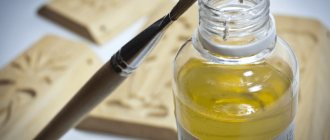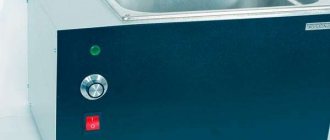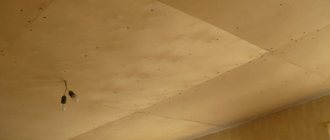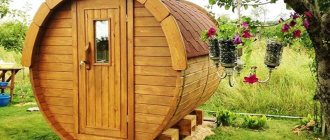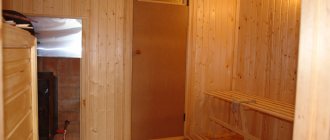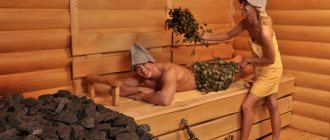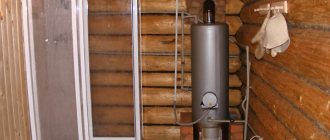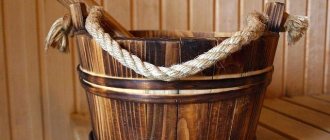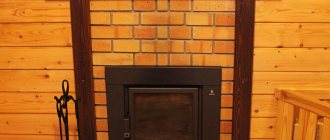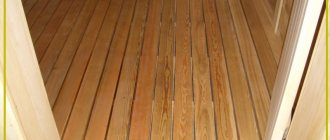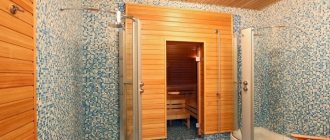Mold that appears in a bathhouse can cause a lot of troubles, one of which is the spoiled interior of the room, and besides, it negatively affects our well-being and health. And even when all the rules of construction and operation seem to be followed, it sometimes becomes difficult to avoid its occurrence.
Let's look at what causes mold, how to prevent it, and how to get rid of mold in a bathhouse.
>
Mold in bathhouses is an enemy of human health
Why does mold appear?
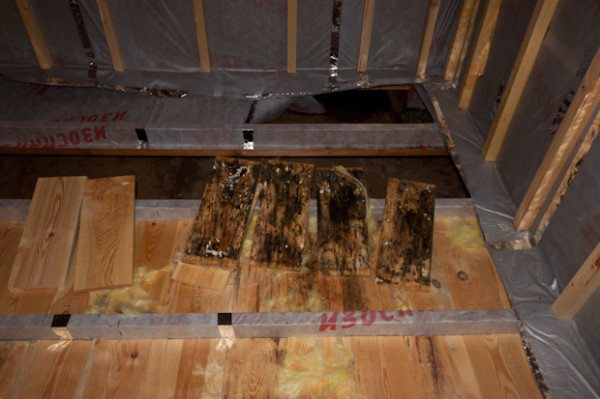
Lack of ventilation is the cause of mold growth
- The foundation has been waterproofed poorly or incorrectly.
- Low-quality wood contaminated with fungus was used, or antiseptic treatment was not carried out.
- The ventilation system is poorly or incorrectly designed.
- The walls of the bathhouse are not insulated, which leads to their freezing.
Prevention of fungus
To avoid having to remove entire sections of damaged wood, adhere to the following preventive recommendations:
- if plumbing breakdowns occur, they are repaired immediately;
- carefully monitor the performance of the ventilation system;
- To keep the room dry, the bathhouse is heated regularly;
- If the sauna is not fully heated, wet things are always removed from there.
After each use, you should clean the room and prevent dirt from accumulating. To do this, use any means intended for sanitary treatment.
Rotting is the result of the impact of various microorganisms on wood, which multiply rapidly at high humidity. In a bathhouse, they most often live on the floor, onto which streams of water constantly fall. If blackness has already affected the wood, the only way to completely remove it is to remove the damaged boards and install new ones.
Logs affected by fungus
The best way to get rid of fungus in a bathhouse is to choose high-quality wood at the construction stage of the room. You cannot take specimens with black or blue veins. If you notice something like this on the wood, it means that the entire batch is damaged, and it is better to contact another supplier.
We suggest you familiarize yourself with How to wash things after a fire
You should buy timber in winter, provided that it was cut down in the frosty months. Cold prevents mold from growing. But in any case, before use, the workpieces are impregnated with an antiseptic.
Before treating the inside of the bathhouse against mold, special compounds are applied to the logs at the time of construction. First, the impregnation is applied to the materials used to build the frame, and then it is applied to boards and other wooden elements indoors.
High-quality impregnations protect wood from sudden temperature changes, prevent exposure to humidity and the proliferation of fungi: “Senezh”, “Neomid”, “Rogneda”, “Belinka”, “Aquacolor”, “Empils” are Russian manufacturers. Among the good foreign products are: Dulux, Nobel, Teknos, Tikkurila.
Not all impregnations are designed for every type of wood. Ceiling products are not suitable for protecting furniture or timber outside. Antiseptics for internal and external impregnation are also different.
To treat timber, antiseptic, insecticidal, and vapor barrier products are used, which are sometimes called industrial because of the strength of their effect. As soon as the bathhouse is built, it is immediately re-treated. This is necessary to prevent dirt and precipitation from penetrating deep into the wood.
Internal impregnation
It is better to treat the floors in the bathhouse from rot and mold with means different from those used to protect walls and ceilings. This is due to the fact that higher demands are placed on the materials with which the human body comes into contact. This is especially true for furniture coatings.
For armchairs, benches and tables, products with water-repellent components based on natural products are used: wax, resins, oils, paraffin. These ingredients are completely safe for humans, but provide good protection to the tree.
What to do to prevent mold from appearing
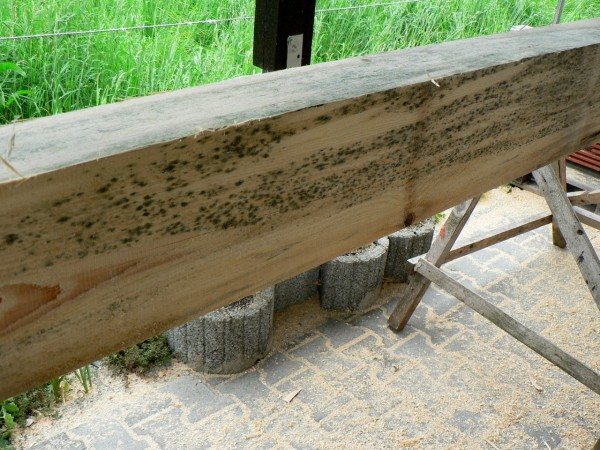
Such material must be processed, and preferably rejected
- To build a bathhouse, wood must be used that was harvested in winter, when there is no movement of juices in the wood. The foundation is laid in the fall, and the frame for the roof is erected in the spring.
- All lumber must be carefully checked at the base, and if contaminated products are found, they should be immediately rejected, and it is best to look for another base.
- Despite the fact that the price of dried lumber is much higher, its use will not allow the initial conditions for mold to appear.
- When using undried lumber, be aware that the ventilation system must be of high quality, or for some time create conditions for artificial ventilation of the bathhouse premises. Operating a bathhouse made from undried material immediately after construction is undesirable. It needs to be dried.
- If the bathhouse has free space under the floor, it should be ventilated.
- You should take care of high-quality ventilation of the attic space, or, if there is an attic in the bathhouse, good ventilation of all rooms, especially the steam room and washing room.
- If the bathhouse is built using frame technology, then vents must be made in the frame ribs.
Prevention of fungus
To effectively protect against mold, it is necessary to think about this even at the stage of design and construction of a room. To prevent its occurrence, you need to pay attention to the lumber. It is advisable to use wood cut down in winter. It is also better to lay the foundation in cold weather, and build the walls and roof in the spring.
Before starting work, experienced builders carefully study the lumber. If traces of fungus are noticed on any log, it is better to replace the batch. Experts have a device that measures the moisture level of the material. This way you can select high-quality wood for building a bathhouse.
During the design process, it is necessary to think through and indicate where the openings for natural ventilation will be located. They need to be done not only underground, but also in the attic. Before construction, you should think about waterproofing the foundation. Load-bearing structures must be protected with vapor barrier. It is advisable to make a powerful hood and treat all parts of the wooden bathhouse with an antiseptic.
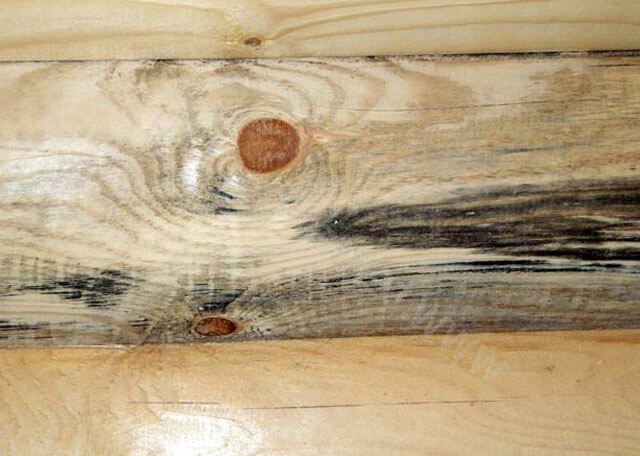
Humidity and poor ventilation are the main, but far from the only factors in the formation of mold spores. We can identify a whole group of reasons for the appearance of fungus on the surface of wood - improper construction and finishing of the “temple of purity”.
The following factors can cause contamination of a bathhouse:
- poor or incorrect foundation waterproofing;
- the use of wood that has been stored for a long time in high humidity conditions;
- the use of low-quality wood that was initially affected by fungus;
- lack of antiseptic treatment or use of inappropriate products;
- poor ventilation, insufficient thermal insulation, leading to freezing of walls;
- unsanitary conditions due to improper use of premises.
The proliferation of microorganisms can be prevented at any stage of sauna arrangement. Physical and chemical methods will help remove fungus from wood in a bathhouse.
Removing mold from bathhouses
Preventive actions
Methods for eliminating mold in a bathhouse are effective when the root causes of its occurrence are eliminated. It occurs most quickly at very high humidity of more than 95%, temperature of more than 20 degrees and, of course, in the absence or poor air ventilation.
Therefore, when deciding what to do if there is mold in the bathhouse, you first need to check the condition of the ventilation system. If necessary, it is cleaned or even redone.
Dirt on the walls and in the corners is also the cause of the appearance and spread of mold. Therefore, the bathhouse premises must be kept clean; the walls themselves cannot be cleaned. Wet cleaning should be carried out after each use of the bathhouse, preferably using regular whitewash.
After all activities have been completed, the bathhouse must be thoroughly dried. And the condition of all premises must be constantly monitored to prevent mold from occurring again.
Traditional methods of getting rid of mold
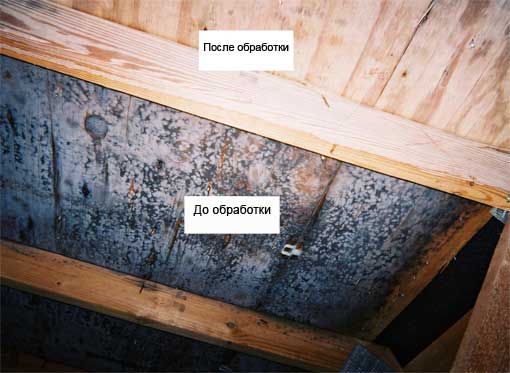
Wood treatment helps get rid of mold
Dealing with mold with your own hands is quite difficult, but it is possible.
It is important to understand that for all treatments the instructions for using folk remedies must be followed.
- Sulfur.
First of all, during processing, all ventilation openings must be closed to prevent leakage of sulfur combustion products. Sulfur is placed in a ceramic or metal vessel at the rate of 20 grams per 10 cubic meters of space.
Combustion products, which is sulfur dioxide, are harmful to both mold and human health, so you cannot stay indoors at this time. With the doors tightly closed, the bathhouse should remain in place for 6-9 hours. Then a box of quicklime is placed, which will absorb sulfur dioxide and also dry out the room.
Attention: When installing the lime box, be sure to wear respiratory protection. Otherwise, you can harm your health and even die.
- Bleaching powder.
First, the walls are cleaned of mold. A concentrated solution of bleach and quicklime is made and the areas where mold occurs are treated with this solution. At the same time, work with gloves and a respirator, because the small size of the spores allows them to penetrate the human body through the skin.
- Inkstone.
A solution that is quite gentle on wood, but has a strong effect on mold. The composition of the solution per liter of water is as follows: iron sulfate - 22 g, potassium alum - 44 g, table salt - 18 g. Using a brush, roller or spray, all surfaces are treated.
- In addition, when deciding how to treat a bathhouse against mold, you can use professional preparations, which are offered in a wide range by the industry.
This product can protect you from mold.
Tip: After any mold removal solutions have been used, the surface should be treated with clean water. The fact is that such solutions have a harmful effect on the human body.
Chemicals
There are many effective ways to combat mold; consider chemical and folk remedies.
Chemical substances
Chemistry destroys mold and prevents its appearance. The most effective means:
- Tikkuril wood impregnations are time-tested. There are edible and colorless options with varying degrees of penetration;
- domestic antiseptics Senezh, Aquatex and Niomid are produced specifically for the destruction of mold;
- Belinka antiseptics can get rid of infection and serve as prevention.
- white. The chlorine content helps to destroy the fungus. The product must be diluted by half with water.
We suggest you familiarize yourself with How to install a water storage tank
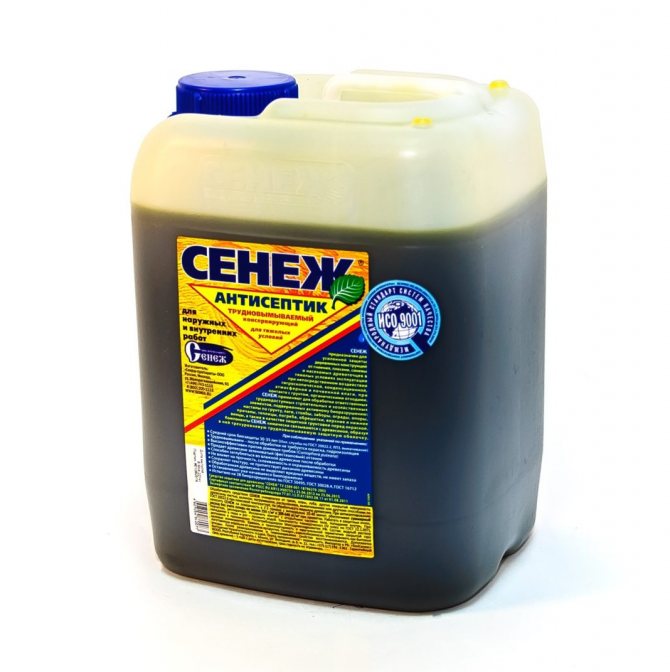
Mold in the bathhouse can be eliminated with Senezh antiseptic
Folk remedies
There are a lot of proven methods for treating mold in a bathhouse:
- Bleaching. An aqueous solution is made and applied to the affected surface.
- Copper sulfate with additives. It is diluted as follows: 100 grams of vitriol, 2 tablespoons of coarse salt, 200 grams of alum are dissolved in two liters of water. All surfaces are washed with the resulting mixture.
- Sulfur. A smoke bomb is made in a metal or any other fireproof container. 200 grams of sulfur is enough for a large bath. Smoldering sulfur produces a gas that kills mold spores. After the checker burns out, it is necessary to ventilate the bathhouse for at least eight hours. Then a solution of quicklime is made and the surfaces are treated. Lime removes residual sulfur dioxide and the smell of sulfur.
- Hydrogen peroxide. The hydrogen peroxide solution is applied to the affected areas until dry. Then it is washed off with water.
- A mixture of vinegar and soda in a ratio of 1 to 1. Can be used in small areas.
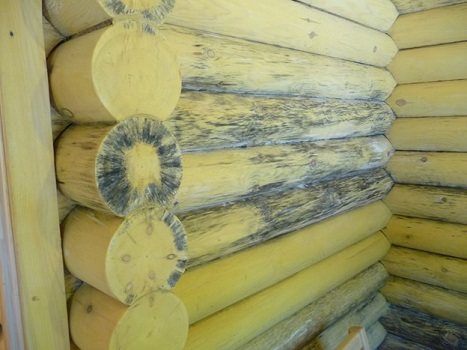
Before using any products, the mold-affected surface must be cleaned with a spatula and a stiff brush.
It must be remembered that only copper sulfate, bleach and sulfur can destroy mold. The rest of the products are good only for washing away the external signs of fungus - spots and blackheads. In case of deep damage, these manifestations may remain even after treatment.
When working with toxic substances, a respirator, safety glasses and gloves are required. Otherwise, harm from them can lead to breathing problems and poisoning.
Chemical compounds must be used carefully. Some of them are absorbed into the wood. When walls, ceilings, and floors are heated, dangerous toxins are released into the air. It is necessary to choose deep penetration antiseptics intended for treating walls, ceilings, and floors of saunas and baths.
Products are divided into three groups: organic, oil-based, combined, and water-based antiseptics. The first two are highly toxic. Water-based septic tanks are designed for treating internal surfaces of premises, including baths. Processing must be done using protective equipment.
When choosing a composition, you must give preference to proven brands - Scandinavian and German brands.
Folk remedies
The simplest and most effective folk remedy is a mixture of bleach and formaldehyde. The ingredients dissolve in water. The composition is applied to a dry surface. You need to be careful, the decorative layer of the walls may deteriorate.
Another composition is prepared from copper sulfate (vitriol) and potassium alum, which are sold in pharmacies.
For one liter take 50 g of vitriol, 100 g of alum. You can add 30 g of regular table salt. The solution is thoroughly mixed and applied with a roller or wide brush to the affected area.
You can fight fungus in a bathhouse with hydrogen peroxide. Take a 25% solution and rub it into a wooden surface. After drying, the surface to be treated is wiped with a damp cloth.
Sulfur will help remove fungus. The way to fight is simple. All ventilation openings are tightly closed. Sulfur is placed in a metal vessel (its amount is calculated by the formula - 20 g per 1 m3), then it is set on fire. Sulfur dioxide spreads throughout the room. It has a detrimental effect on fungal colonies. The lime should burn for about nine hours. Then a box of quicklime is brought into the bathhouse. It absorbs toxic fumes.
When installing the box, you need to be careful and protect your respiratory system. Sulfur fumes are harmful to health. In high concentrations they can be lethal.
The best way to combat mold is to prevent its occurrence.
We invite you to review the 10 best types of sauna stoves
Conclusion
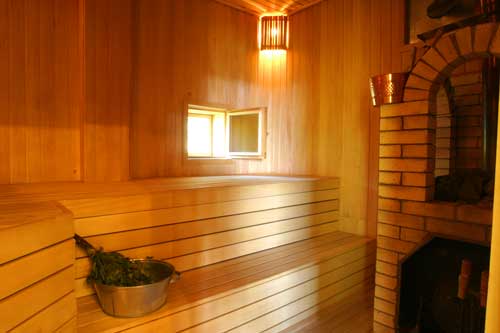
A clean, ventilated room is the key to good rest
Of course, when deciding how to remove mold, you first need to think about the fact that it is easier to prevent its appearance than to remove it after it appears. Simply rinsing will not remove dirt, so you need to wash the sauna regularly and thoroughly. In addition, periodically treat with preventative agents.
Our portal is ready to provide additional information on this issue, which is also contained in the proposed photos and videos in this article.
Did you like the article? Subscribe to our Yandex.Zen channel
Getting rid of fungus mechanically
If the room is not constantly heated, this is a favorable environment for the formation of fungus. The greatest importance should be given to wooden buildings, since they are in the main risk group.
Mold can appear on any surface in a room with high humidity. The fungus multiplies on the floor, ceiling or walls, as well as in corners. If the steam room is poorly insulated, mold will form there very soon. When the first symptoms of a fungus are detected, it is necessary to immediately begin its removal. There are three known ways to get rid of fungus in a bathhouse:
- Folk remedies.
- Mechanical. Cleaning the surface with a brush or sander.
- Store-bought drugs.
Folk methods or store-bought remedies mean treating contaminated material with aggressive substances.
In a bathhouse, the floor is often contaminated with fungus. In this case, it is advisable to remove boards with mold and remove some of the soil. She may also be infected. Boards with fungus must be replaced immediately. Treat the rest with antiseptic agents.
To avoid similar problems in the future, the bathhouse must be heated daily and well ventilated after its intended use. If mold appears in the bathhouse, you need to know how to get rid of it. You can use a store-bought product designed to kill fungus.
Before you begin treating the ceiling, walls, corners and floors, you must carefully inspect the ventilation system. The first step is to open the shutters and inspect the ventilation duct. Some owners of baths and saunas effectively eliminate the source of mold by installing a fan near the grilles.
The ventilation system itself can be treated with a special primer. It is necessary to choose a product designed to work with wooden surfaces. But at the same time, adhere to the dosage and take precautions so as not to burn the skin.
Special professional preparations will help get rid of fungus quickly and for a long time. It is advisable to choose products from well-known manufacturers, such as Biotop, Ceresit, Metas-Bio, Dali, Neomid-Bio. When purchasing chemicals from unknown companies, there may be no effect, but the money will be wasted.
The cost of the funds varies depending on the manufacturer. Special chemical compounds must be used carefully. Some are strongly absorbed into the wood, and then, as the ceiling, floor and walls heat up, they begin to release toxins into the air that are harmful to health. It is necessary to buy a ready-made deep penetration composition intended specifically for treating the ceiling, floor and walls of baths and saunas.
If the fungus has not penetrated very deeply, you can try to clean the affected surface. The work is not very difficult.
For this you will need:
- Emery.
- Putty knife.
- Sander.
- Metal brush.
After removing mold mechanically, it is best to incinerate the waste. Thanks to this, the development of mold on other objects will be prevented. Mechanical cleaning is used when the fungus penetrates deeply. Part of the log is cut out and new material is inserted there.
Traditional methods
Fungus in a bathhouse can be destroyed using folk methods. They are effective and do not take much time.
To combat mold use:
- Bleach, consisting of water and quicklime. The solution is applied to the prepared dry surface.
- Copper sulfate, which can be purchased at gardening stores. To obtain a solution, you need to take 50 grams of vitriol, 30 grams of table salt and 100 grams of potassium alum per 1 liter of water. Before treating the walls with the product, you need to dry the surface, make a solution according to the instructions, and apply it to the walls with a brush. Repeat the procedure after two weeks.
- Seru. This method is cheap and effective. It is necessary to set fire to a sulfur bomb in a basin or bucket. When burned, it releases gases, effectively eliminating fungal spores.
- Hydrogen peroxide 25%. You need to carefully apply it to the wood and leave it. After a few hours, wipe the surface with a damp cloth.
- Whiteness. It is sold in any store at an inexpensive price. Apply the product to the walls, then treat them with water.
- You can coat the surfaces of the logs with 70% acetic acid. But this solves the problem only temporarily. The ventilation system needs to be repaired.
Mold can be removed using store-bought products, folk methods, and mechanical methods for safely processing wooden surfaces. Before getting rid of mold in a bathhouse, you need to evaluate the pros and cons, as well as the effects of different substances and tools on wood.
Physical methods of influence include processing logs with the following tools:
- sandpaper of different grain sizes;
- putty knife;
- Sander;
- drill with a hard bristle attachment;
- manual steel brush.
We suggest you read: Bugs have appeared in cereals, how to get rid of them
Before removing the spores, the extent of damage to the boards is determined. If microorganisms have eaten away the wood deeper than 1 cm, it will not be possible to remove it with a nozzle or brush.
Before treatment, the affected area is moistened with water. Once removed, contaminated material is incinerated rather than discarded. If fungi have penetrated inside the tree, you will have to replace the section of logs, boards or lining.
If you don’t like chemical antiseptics for fungus, you can try homemade methods based on available products. One of the most popular is the use of bleach. It is applied to a dry damaged surface, after mixing with water. Additionally, you can add some formaldehyde to the composition.
Folk remedies for mold
Other methods of treating surfaces in the bath and in the sink:
- A mixture based on copper sulfate - add 1 liter to 50 g of the substance. water, 30 g of salt and 100 g of potassium alum. You can spread the solution over logs and boards with a roller, and coat the cracks with a brush.
- Sulfur mixture - before use, close all doors and windows, and set fire to a sulfur bomb in a bucket or other fireproof container. For processing 1 cubic meter. use 2 g of the substance. People should not be allowed to be present while cleaning the premises. After 8 hours, a bucket of quicklime is placed in the bathhouse to eliminate gas and moisture.
- Hydrogen peroxide is an excellent remedy for getting rid of mold in rooms with thin boards. Apply 20-25% of the substance, applying it to damaged areas. After 3-4 hours, wipe the surface with a damp cloth.
- Preparations based on “Whiteness” will help remove fresh mold. They are applied for 1-2 hours and then washed off with clean water.
Less common is the use of ammonia, vinegar and pure alcohol. But this method is also effective. Ammonia is diluted with water in half, and vinegar 9% and alcohol are taken undiluted. The compositions need to be applied for 3-4 hours, after which the area is washed well.
There are universal preparations that help remove any type of mold. They are especially effective against blue, black plaque, resistant to traditional methods of influence:
- Homeenpoisto;
- Fongifluid;
- Senezh-Effo;
- Olymp Stop-Plesen;
- Dali;
- Neomid Bio.
When working with chemicals, wear protective masks and gloves. After use, surfaces are thoroughly washed with water.
Before treating the fungus in a bathhouse, it is worth determining the depth of the lesion. Based on this, the following tools can be used: a spatula, sandpaper, a steel bristle brush, a drill with a brush attachment, a grinder, and so on. It is preferable to incinerate all removed waste.
If mold has penetrated inside the wood, then only complete replacement of the damaged area will help. In some cases, parts of the bars are cut out, and new ones are installed in their place.
